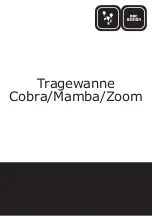
17
Multiple Motors
The TR1 can control several motors at once, all changing speed
together. The sum of the nameplate currents of all the motors must not
exceed the current rating of the drive.
CAUTION
Motor Damage!
When multiple motors are used, the drive
electronic thermal relay cannot be used to
provide individual motor protection. A separate
motor overload must be supplied for each
motor. Failure to provide individual motor
protection when multiple motors are used could
result in motor or equipment damage.
If the multiple motors are of significantly different sizes, starting problems
may occur. This is because the higher electrical resistance of smaller
motors will require more start voltage than larger motors.
NOTE
Automatic†Motor Adaptation and Automatic
Energy Optimization cannot be used for
multiple motor installations.
External DC Bus Connection
Terminals 88 and 89 access the DC bus of the drive. They can provide
DC backup power for the drive or to connect to a 12-pulse input
rectifier.
WARNING
!
Hazardous Voltage!
Terminals 88 and 89 will be at approximately
150% of line voltage and remain at high voltage
for up to 30 minutes after power has been
removed from the drive. To be sure that
capacitors have fully discharged, wait 14
minutes for 208 V and 480 V units and 30
minutes for 600 V units after power has been
removed before touching terminals 88 and 89.
Failure to wait for capacitors to fully discharge
before touching DC bus terminals could result
in death or serious injury.
CAUTION
Equipment Damage!
Do not connect anything to terminals 88 and 89
without first consulting with Trane. Failure
consult with Trane could result in motor or
equipment damage.
High Voltage Form C Relay
The connections for the high-voltage relay are terminals 01, 02, 03.
The high-voltage relay is programmed in parameter 323,
Relay
Output 1.
1+3 normally closed, 1+2 normally open
Max. 240 VAC, 2 Amp
Min. 24 VDC, 10 mA or
24 VAC, 100 mA
Max. wire gage:
10 AWG (4 mm
2
)
Terminal Torque: 5 in-lbs ( 0.5 - 0.6 Nm)
















































